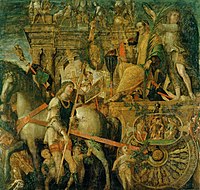Trionfo
Trionfo (Italian:
Another specialized sense of the word was an elaborate sugar sculpture; these decorated tables on important occasions in the Renaissance and Baroque periods, especially in Italy and France. Eventually they were replaced by the silver surtout de table or porcelain centrepieces.[1]
The word may derive from a call of triumph during antique triumphal processions: "Io triumpe".
Art and literature
Triumphs were described in literature, the cars often carrying classical gods or
Other
The Italian sculptor Giuseppe Cassioli named his Olympic medal design Trionfo. First used in 1928, the design was used for Summer Olympic Games until it was replaced at the 2004 Olympic Games.
-
Relief on the Castel Nuovo, Naples, 1470. It shows the entry of Alfonso V of Aragon after taking the city.
-
Allegories on the back of thedouble portrait of Battista Sforza and Federico Montefeltro, by Piero della Francesca, c. 1465-1472. Horses pull Federico’s car and Battista’s is pulled by unicorns.[2]
-
Triumph of Jehoshaphat, Jean Fouquet, 1470–75.
-
Julius Caesar in his truiumphal car, in one of the nine scenes of the Triumphs of Caesar by Andrea Mantegna (by 1492)
-
Woodcut illustration to Hypnerotomachia Poliphili, with centaurs pulling the car, 1499.
-
Leopards pullBacchus's car in Titian's Bacchus and Ariadne(1523)
-
The Trionfo design of Giuseppe Cassioli on a 1960 Olympic medal
Notes
References
- ISBN 0224061380


![Allegories on the back of the double portrait of Battista Sforza and Federico Montefeltro, by Piero della Francesca, c. 1465-1472. Horses pull Federico’s car and Battista’s is pulled by unicorns.[2]](http://upload.wikimedia.org/wikipedia/commons/thumb/0/01/Piero_della_Francesca_047.jpg/200px-Piero_della_Francesca_047.jpg)




